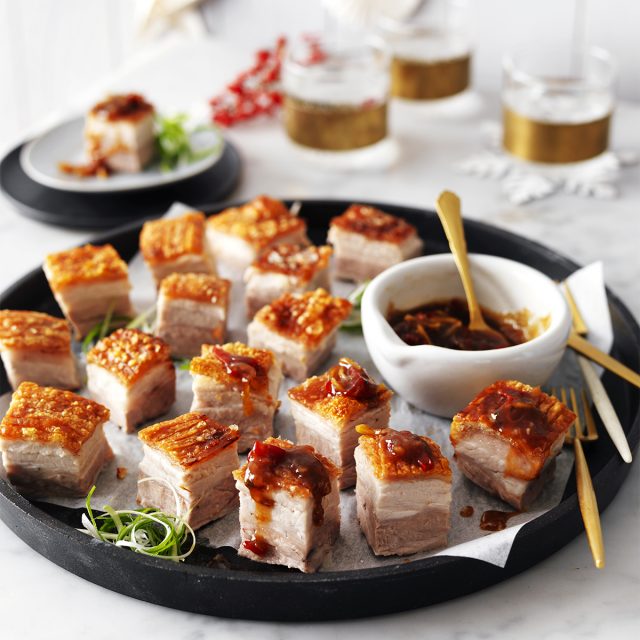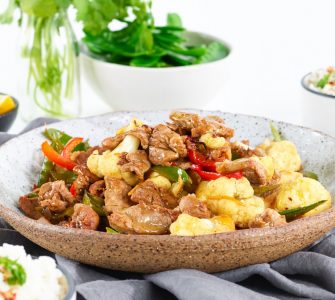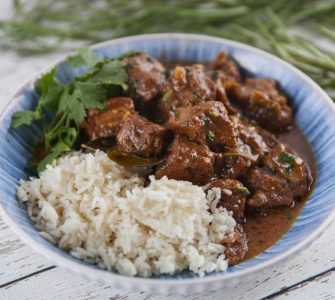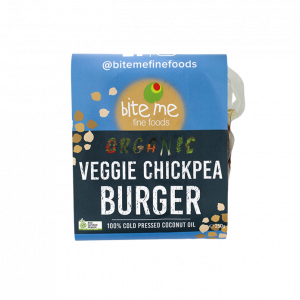How to get shatteringly crisp crackling, juicy meat and a tangy-sweet tamarind and chilli finish, using practical tips trusted by Aussie home cooks.

Crispy Pork Belly as a “Treat Night” Centrepiece
Pork belly has become a bit of a rockstar cut in Australian kitchens, showing up on pub menus, at Christmas lunches and in weekend roasts where people want something that feels special but still familiar. It’s rich, layered with fat and meat, and absolutely not an everyday dinner, which is part of its charm.
Because it’s such a rich cut, a little goes a long way. A good guide is around 200–250 g of raw pork belly per adult, which usually lands you at roughly 150–200 g once it’s cooked and some of the fat has rendered. That’s enough for a generous serve, especially when you add sides like greens, roast veg or rice, and it helps you shop sensibly rather than dragging home a whole slab “just in case”.
One big advantage of belly is how forgiving it is. Compared with lean cuts like loin or fillet, the higher fat content gives you a buffer against overcooking; the meat stays moist even if you go a few minutes beyond your target time. Many Australian roasting guides focus on belly for this reason, pairing moderate oven temperatures with clear time-per-kilo rules, so home cooks aren’t stuck second-guessing every step.
Think of this dish as a “special treat”, something you plan, enjoy, and then tuck away again for another special occasion. Framed that way, the effort feels worth it, and the portion guide keeps both budget and richness under control.
Crackling 101; Skin Prep That Actually Delivers
Every pork belly recipe lives or dies on the crackling. People remember that first bite of salty, glassy, puffed skin more than any side dish, so it’s worth being a bit fussy about how you prep it. Australian Pork and other local guides hammer home the same core message: dry skin, scored rind, and salt are non-negotiable.
Start with dry skin. Pat the rind very thoroughly with paper towel, then keep going until it feels almost squeaky. Excess moisture is the enemy of blistering; if the surface is damp, the heat spends its energy steaming rather than crisping. That’s why so many professional and home methods add an extra step of leaving the belly uncovered in the fridge for several hours or overnight to help the skin dehydrate.
Scoring is next. You want shallow cuts through the rind and fat, but not into the meat itself. This lets fat escape as it renders and gives the salt somewhere to sit, which both improves crackling and seasons the slices more evenly. Many Australian butchers will happily score the rind for you at the counter, which is worth asking for if you’re nervous with a knife at home.
Once the rind is dry and scored, rub in a neutral oil and a generous amount of salt, pushing it into the cuts. The oil helps the heat move evenly across the surface, and the salt helps pull remaining moisture out while seasoning the crackling itself. You’ll see similar patterns whether you’re reading a classic roast pork belly recipe, a Chinese-style crisp belly method or an Italian-inspired version; the prep fundamentals keep repeating for a reason.
Low and Slow, Then Hot, Oven Timing for Juicy Meat & Shattering Rind
Once the skin is prepped, the oven does most of the work. Many trusted Australian guides for pork belly recommend a two-stage roast: a hot start to kick-off the crackling, then a moderate temperature long enough to cook the meat through. For example, Australian Pork suggests roasting belly or rolled belly at around 240 °C until the rind starts to crackle and colour, then dropping to about 180 °C to finish cooking using a minutes-per-kilo rule.
RecipeTin Eats and similar sites often flip the order, roasting low first to render the fat and keep the meat extra juicy, then turning the heat right up at the end to get the crackling to the bubbly, blistered stage. Either way, the pattern is the same: one phase for tenderness, one phase for texture. That’s good news for home cooks, because it means you can choose the approach that fits your schedule and oven quirks.
Time-per-kilo guides are handy, but a meat thermometer is your real safety net. Australian food-safety advice typically suggests cooking whole pork cuts and roasts to around 70–75 °C in the centre, then resting, to keep both safety and eating quality on track. If your thermometer reads at least 71 °C in the thickest part of the belly before you rest it, you’re within those recommended ranges and can relax.
Resting matters too. Taking the pork out of the oven and letting it sit for 10–20 minutes gives the juices time to settle back into the meat, so they don’t run straight onto the board when you slice. Many Australian roasting guides include this step as standard, even for leaner roasts, and it’s arguably even more helpful with a rich cut like belly.
If your crackling isn’t quite there when the meat is done, you can return the belly to a very hot oven or slide it under a grill for a short blast, keeping a close eye so you don’t scorch the surface. That “finish at high heat” step mirrors advice from multiple sources and can turn “pretty good” crackling into the shattering stuff guests talk about later.
Sticky Tamarind & Chilli Jam, Cutting Through the Richness
All that fat and crisp skin begs for acidity and heat. Tamarind brings both. It has a sour, fruity flavour that’s widely used in South and South-East Asian cooking to sharpen curries, stir-fries and sauces, and it pairs especially well with pork’s sweetness. Several Australian pork belly recipes lean on tamarind purée combined with sugar, fish sauce or soy, garlic and chilli to create sticky glazes or jams that cling to the meat.
In a sticky jam or glaze, tamarind usually sits alongside sugar and umami-rich ingredients. The sugar helps the sauce thicken and caramelise, clinging to crisp edges and catching in the cuts of the scored rind. Fish sauce or soy pull things back from dessert territory, adding depth and salt that balances the sweetness. The result is a glossy, clingy coating that sticks to the knife, the board and your fingers in exactly the way you want.
Chilli jam ties in perfectly here. You can start with a milder jam if you’re feeding kids or chilli-shy guests, or use a hotter version and thin it slightly with tamarind and water. Australian recipes that combine belly with sweet chilli or other sticky chilli sauces often highlight how the heat cuts through the richness without making the dish feel heavy, which is exactly what you want with a fatty cut.
For serving, think about balance on the plate. Crunchy slaw with herbs and a tangy dressing, pickled vegetables, fresh cucumber or citrus wedges all play nicely with tamarind and chilli. That kind of contrast shows up repeatedly in local pork belly recipes, from soft milk-braised versions with greens to Vietnamese-style banh mi piled with crisp salad and fresh herbs.
Plan-Ahead Prep, Fridge Time, Marinating and Leftovers
One of the best things about pork belly is that so much of the work happens before guests arrive. Skin-drying, scoring and rubbing with salt can all happen the day before. Many slow-roast belly recipes suggest an overnight stint in the fridge, uncovered, for maximum crackling; you can piggy-back on that time by rubbing the meat side with a tamarind-based marinade at the same time, letting the flavour gently work its way in.
From a food-safety point of view, pork is firmly in the “perishable” camp. Food-safety bodies in Australia recommend keeping raw meat at or below 5 °C, and cooking potentially hazardous foods so the centre is at 70 °C or hotter to keep harmful bacteria in check. When you’re prepping ahead, that means: back into the fridge promptly after rubbing or trimming, and into a preheated oven when you’re ready to cook, rather than letting the belly sit out on the bench for hours.
Leftovers can be a gift. Once the cooked belly has cooled, you can store it in the fridge for up to a few days or freeze it for longer, provided you pack it into a clean, airtight container and chill it promptly. Food-safety organisations suggest cooling and refrigerating cooked meats within about two hours, then reheating leftovers until they’re steaming hot all the way through, aiming above 60 °C as a minimum holding temperature.
Think beyond reheated slices. Crisp-edged cubes of leftover belly can go into fried rice, noodle bowls, soft rolls with pickled veg, or quick tacos with crunchy slaw. The sticky tamarind and chilli coating works especially well in these second-day dishes, giving you a lot of flavour with very little extra effort. Australian food media often highlight these “cook once, eat twice” ideas for richer cuts, both to justify the spend and reduce waste.
Butcher & Shopping Notes: Choosing the Right Piece of Belly
Good pork belly starts at the counter. When you’re ordering at Church Street Butcher, ask for a skin-on piece with even thickness from end to end, and visible layers of meat and fat rather than one huge fat cap. Guides from Australian Pork and other local educators often show side-on photos of belly so you can see that balance; it’s worth taking a moment to look before you buy, especially if you’re cooking for guests.
Size is the next decision. Use the 200–250 g raw weight per adult as a rough rule, then round up slightly if you’d like leftovers. If you’re unsure, your butcher can help you size the piece to match your guest list and your roasting pan. Belly can come as a long, flat slab or rolled and tied; both can deliver excellent crackling, but flat slabs are often easier for a first go, because you can see the whole rind at once.
If scoring makes you nervous, ask the butcher to do it for you while you’re there. Most are happy to run a sharp knife across the rind in neat, shallow lines, saving you the worry of cutting through to the meat. You can still tidy any excess fat at home, square off the edges so the belly cooks evenly, and follow all the same drying and salting steps. This sort of collaboration is exactly what independent butchers are there for, and they often have cut-specific tips that go beyond what a recipe can cover.
When you’re at the counter, it’s also a good moment to ask about provenance. Many Australian shoppers care about where their pork comes from and how it’s raised, and plenty of butchers are proud to talk about the farms they source from. You don’t need a lecture on feed regimes; even a simple “Is this free-range?” or “Where’s this from?” can give readers language they feel comfortable using.
This delicious pork belly can also be served as a main meal when teamed with an Asian salad and steamed jasmine rice.
Ingredients
- 1 x 2 kilogram Piece boneless pork belly (see tip in)
- 1 tablespoon Olive oil
- 2 teaspoon Sea salt flakes
- Shredded green onions (shallots) (to serve)
Sticky Tamarind & Chilli Jam
- 2 teaspoon Peanut oil
- 1 tablespoon Ginger (finely shredded)
- 2 clove Garlic (finely chopped)
- 1 long Red chilli (deseeded and thinly sliced)
- ¼ cup Caster sugar
- 1 ½ tablespoon Tamarind puree
- 2 teaspoon Fish sauce
Instructions
- Preheat the oven to 240°C/220°C fan forced. Using a sharp knife, score pork rind at 1cm intervals. Rub with oil and sea salt.
- Place a rack in a large roasting pan. Pour 3 cups of water into the roasting pan. Place pork skin side-up on the rack. Roast pork for 40-45 minutes or until the skin is golden and crackled.
- Reduce heat to 170°C/150°C fan-forced and roast for a further 40 minutes or until the pork is very tender.
- Meanwhile, to make the sticky tamarind jam, heat oil in a small saucepan over high heat. Add ginger, garlic and chilli and cook, stirring, for 1 minute or until aromatic. Reduce heat to low. Add ¼ cup of water, sugar, tamarind puree and fish sauce. Stir to dissolve the sugar. Reduce heat and simmer, stirring occasionally, for 7-8 minutes or until the jam is thick and sticky. Remove from heat and set aside.
- Remove pork from oven. Set aside to rest for 10 minutes. Slice pork into small squares. Arrange pork on a platter. Serve with sticky tamarind jam and shredded green onions.
Notes
Tips:
For the best crackling, place the pork belly skin side-up onto a tray lined with baking paper and refrigerate overnight to dry out the rind.
Remove the pork belly from the fridge 1 hour before scoring the skin.
Crispy pork belly with sticky tamarind and chilli jam isn’t weeknight food; it’s something you plan, prep and look forward to. With the portion guide in mind, a clear approach to skin prep, a two-stage roast, and a tangy-sweet sauce that cuts through the richness, it becomes much less mysterious and much more achievable for home cooks. Our make-ahead tips mean you can focus on timing and conversation, rather than worrying about whether it’s cooked or if the crackling will work.
Next step: use this guide as your briefing note, then follow the recipe method from start to finish. Bring these notes to our friendly staff, ask for a piece that suits your guest list, and treat yourself and your crew to proper crackling and a sauce that refuses to be ignored.
 Easy Pork Stir-Fry
Easy Pork Stir-Fry The Ultimate Guide to Glazed Christmas Hams
The Ultimate Guide to Glazed Christmas Hams Slow Cooked Pork Curry
Slow Cooked Pork Curry
